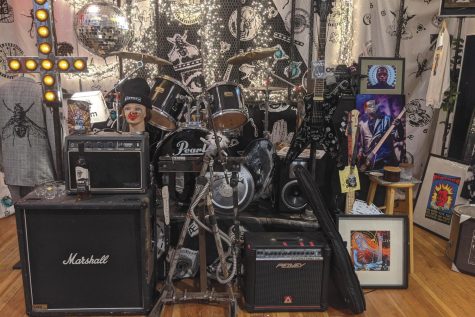Punk drummer Martin Atkins harnesses DIY spirit to create Museum of Post-Punk Music
June 21, 2022

Editor’s note: This article is from the Communication Department’s award-winning Echo magazine.
The Museum of Post-Punk and Industrial Music sits on a quiet street, in a nondescript brick building that stretches a bit farther back than the houses on either side. Trees irregularly line the street, dappling the sun’s light and casting pedestrians in a kaleidoscopic tint. It is, by nearly every account, just another street in Chicago.
Housed in this unremarkable building along this unremarkable street in Bridgeport is an ever-growing assemblage of artifacts and mementos that speak volumes about the post-punk movement. But for Martin Atkins, the museum’s curator and a world renowned drummer, it’s about much more than the objects themselves — it’s about picking through the rubble and finding the pieces of yourself that came away with the noise. As Atkins himself puts it, it’s about honoring “the church of vibe.”
From that rubble come memories that only grow more vivid over time. Atkins says he didn’t anticipate receiving the outpouring of support that he has, nor did he realize just how many relics his fans kept close.
“I’ve never seen anything with such a groundswell of support and momentum,” Atkins says. “This is a very DIY, post-punk way of doing things. Like, ‘We’re doin’ it. Who’s in?’”
The idea of creating a museum came to him in early 2021. Now, a year or so later, the drummer-turned-music professor-museum curator is beginning to wrap his head around what he’s started. He has also started to work on a 100-page museum catalog, which he admits is two months behind schedule but which he’s immensely proud of.
By day, Atkins is the coordinator of music business at Millikin University in Decatur, Illinois. By night (and weekends), he builds the Museum of Post-Punk and Industrial Music from the ground up. Atkins garnered international fame for co-forming industrial rock supergroup Pigface, playing with Killing Joke and Nine Inch Nails, and dedicating his life to teaching students what life in the music business looks like.
The museum is not open to the public … except for when it is. Atkins funds the museum with an unofficial Founders program. Atkins wanted to keep the “velvet rope” idea alive, while still offering occasional events that non-members can attend. He calls it basic nightclub promotion.
Albeit infrequent, the opportunity for the general public to experience this space do exist, from field trips to pancake, whiskey and mimosa brunches.
The museum is gaining recognition beyond Chicago. Tate Wittenberg, a filmmaker who finished working on a documentary about the legendary Tulsa music venue Cain’s Ballroom, said over email, “The museum just seems like a natural progression for Martin. He’s such an integral player in the post punk and industrial worlds, and he has saved everything from famous clothing articles to even things like the fencing from Ministry’s infamous Cage Tour. He’s such a natural at putting on events; it’s really the perfect outlet for him, and nobody could do it better.”
Martin decided early on that he wanted the museum to be unlike any other of its kind.
“When I look at other museums, there’s a very sterile presentation. It can be like, ‘Here’s this band!’ And then there’s a press photograph, maybe a press release from the label with, like, a rubber stamp on it or something, and then the album itself with a photograph and maybe a backstage pass.”
Atkins trails off, as if he’s lost in the very things he’s remembering. He shakes his head and says, “To me, that’s a starting point. Like I’ve got a bag of receipts from when we went to Poland to pick up the bass to do the thing, the currency change, or the hotel bills for everybody, everybody signing for their meal money — it’s all this behind-the-scenes stuff that really takes me on a journey.”
“And then you start to realize, everybody’s got one thing,” he says, leaning forward on the sectional he’s angled toward his drum set. “A smashed key from a Nine Inch Nails keyboard. A flier [a fan] grabbed on the way out. The suit from Skinny Puppy. Stuff that they bought and felt connected to, but they also had this feeling that it doesn’t belong to them. It’s this 3-D collage of shit.”
That feeling is the fuel behind this endeavor. Most of the memorabilia adorning the walls and crowding the hardwood floor was pulled from Atkins’ personal collection. His drum set, the same one he used for countless live shows, serves as the museum’s centerpiece. Proudly displayed on a plastic torso nearby is a jacket worn by Johnny Rotten during his Sex Pistols days.
And while Atkins quit recording years ago, the energy of this museum is reigniting an old fire. Now, he’s open to returning to the studio and making new music.
“There’s this unexpected rush of creativity that, for me, I just didn’t anticipate. It’s not always about looking at these objects. It’s looking at a creative path.”
For him, and for punk lovers everywhere, that’s the true magic at work here.
You can read the entire 2022 issue of Echo, as well as previous issues, on our website.







